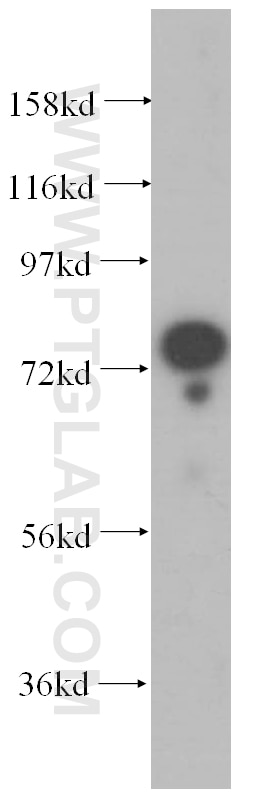Validation Data Gallery
Tested Applications
| Positive WB detected in | HeLa cells, mouse testis tissue, human kidney tissue, HepG2 cells |
| Positive IP detected in | HeLa cells, mouse testis tissue |
| Positive IF/ICC detected in | MDCK cells |
Recommended dilution
| Application | Dilution |
|---|---|
| Western Blot (WB) | WB : 1:2000-1:8000 |
| Immunoprecipitation (IP) | IP : 0.5-4.0 ug for 1.0-3.0 mg of total protein lysate |
| Immunofluorescence (IF)/ICC | IF/ICC : 1:200-1:800 |
| It is recommended that this reagent should be titrated in each testing system to obtain optimal results. | |
| Sample-dependent, Check data in validation data gallery. | |
Published Applications
| KD/KO | See 3 publications below |
| WB | See 6 publications below |
| IHC | See 1 publications below |
| IF | See 1 publications below |
Product Information
13897-1-AP targets GTPBP4 in WB, IHC, IF/ICC, IP, ELISA applications and shows reactivity with human, mouse samples.
| Tested Reactivity | human, mouse |
| Cited Reactivity | human, mouse, drosophila |
| Host / Isotype | Rabbit / IgG |
| Class | Polyclonal |
| Type | Antibody |
| Immunogen | GTPBP4 fusion protein Ag4859 相同性解析による交差性が予測される生物種 |
| Full Name | GTP binding protein 4 |
| Calculated molecular weight | 634 aa, 74 kDa |
| Observed molecular weight | 74 kDa |
| GenBank accession number | BC038975 |
| Gene Symbol | GTPBP4 |
| Gene ID (NCBI) | 23560 |
| RRID | AB_2279486 |
| Conjugate | Unconjugated |
| Form | Liquid |
| Purification Method | Antigen affinity purification |
| UNIPROT ID | Q9BZE4 |
| Storage Buffer | PBS with 0.02% sodium azide and 50% glycerol , pH 7.3 |
| Storage Conditions | Store at -20°C. Stable for one year after shipment. Aliquoting is unnecessary for -20oC storage. |
Background Information
GTP-binding proteins are GTPases and function as molecular switches that can flip between two states: active, when GTP is bound, and inactive, when GDP is bound. 'Active' in this context usually means that the molecule acts as a signal to trigger other events in the cell. When an extracellular ligand binds to a G-protein-linked receptor, the receptor changes its conformation and switches on the trimeric G proteins that associate with it by causing them to eject their GDP and replace it with GTP. The switch is turned off when the G protein hydrolyzes its own bound GTP, converting it back to GDP. But before that occurs, the active protein has an opportunity to diffuse away from the receptor and deliver its message for a prolonged period to its downstream target.
Protocols
| Product Specific Protocols | |
|---|---|
| WB protocol for GTPBP4 antibody 13897-1-AP | Download protocol |
| IF protocol for GTPBP4 antibody 13897-1-AP | Download protocol |
| IP protocol for GTPBP4 antibody 13897-1-AP | Download protocol |
| Standard Protocols | |
|---|---|
| Click here to view our Standard Protocols |
Publications
| Species | Application | Title |
|---|---|---|
Genes Dev Uncoupling of GTP hydrolysis from eIF6 release on the ribosome causes Shwachman-Diamond syndrome. | ||
Proc Natl Acad Sci U S A A genome-scale protein interaction profile of Drosophila p53 uncovers additional nodes of the human p53 network.
| ||
Biochem Biophys Res Commun Up-regulation of GTPBP4 in colorectal carcinoma is responsible for tumor metastasis.
| ||
Biomed Res Int Determining the Clinical Value and Critical Pathway of GTPBP4 in Lung Adenocarcinoma Using a Bioinformatics Strategy: A Study Based on Datasets from The Cancer Genome Atlas.
| ||
Cell Rep UTP18-mediated p21 mRNA instability drives adenoma-carcinoma progression in colorectal cancer | ||
Nucleic Acids Res Distinct interactomes of ADAR1 nuclear and cytoplasmic protein isoforms and their responses to interferon induction |





